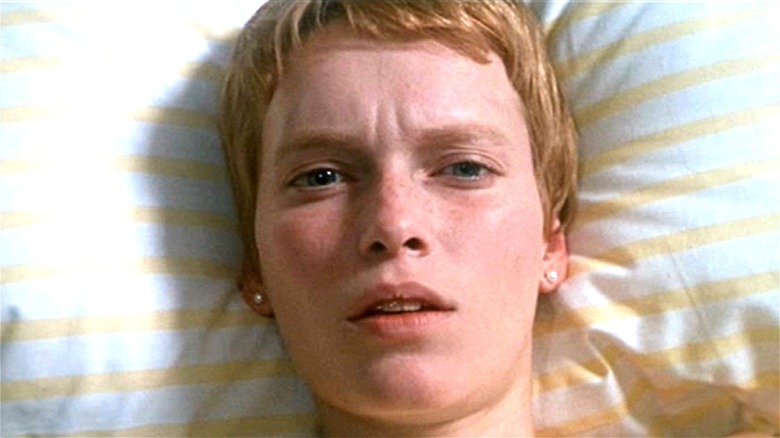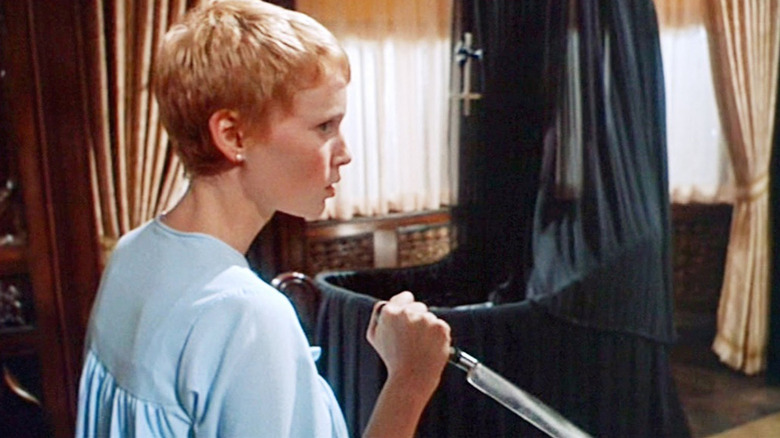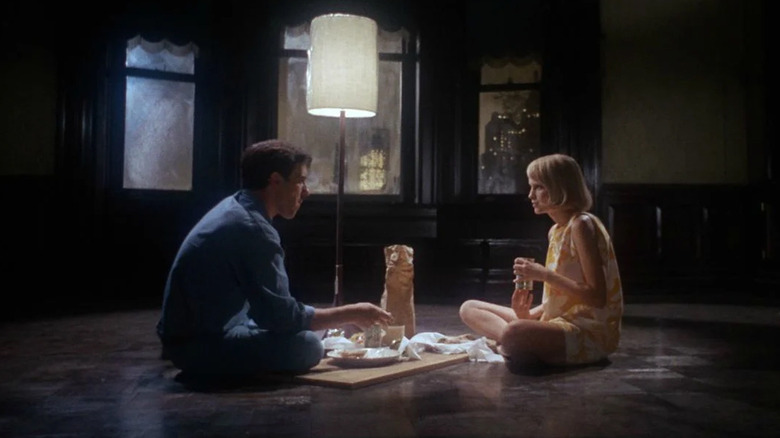The Controversy Around Rosemary's Baby Explained
"Rosemary's Baby" is among the most celebrated horror films of all time. In fact, "Rosemary's Baby" is one of the 12 highest-rated horror movies on Metacritic based on an scores aggregated from professional reviewers. One review from around the time of its release, by famed Chicago Sun-Times critic Roger Ebert, describes it as "a brooding, macabre film, filled with the sense of unthinkable danger," as well as, more simply put, "very good."
Upon the film's opening, married couple Rosemary (Mia Farrow) and Guy (John Cassavetes) are in the process of moving into a new apartment in New York City. Their new life in the Big Apple is upended, however, when Rosemary becomes pregnant after an unusual dinner with an older couple from a neighboring apartment. Her health soon begins to suffer, seemingly as a result of her suspicious pregnancy.
While many of the horrors of "Rosemary's Baby" aren't necessarily out of the ordinary by today's standards, audience expectations were understandably quite a bit different at the time of its 1968 release. Furthermore, its director Roman Polanski was charged with sexual abuse of a minor in the years following. While Polanski's legacy may complicate the film's reputation today, the film's subject matter alone proved controversial from the get-go.
If you or someone you know may be the victim of child abuse, please contact the Childhelp National Child Abuse Hotline at 1-800-4-A-Child (1-800-422-4453) or contact their live chat services.
Rosemary's Baby preceded the Satanic Panic
Beginning in the 1980s, fear of a real-life devil and its worshippers became so widespread that the phenomenon became known as the Satanic Panic. While "Rosemary's Baby" may predate this, its satanic subject matter was nevertheless controversial among a sizable contingent of its audience.
Ira Levin, who wrote the book on which "Rosemary's Baby" is based, recounts some of the backlash to the film's content in a 2003 essay published by the Criterion Collection. "The movie of 'Rosemary's Baby' attracted some of the hostility I had worried about while writing the book. A woman screamed 'Blasphemy!' in the lobby after the first New York preview, and I subsequently received scores of reprimanding letters from Catholic schoolgirls, all worded almost identically," Levin explains.
In the end, Levin questions whether the film — in conjunction with some subsequent horror movies featuring devilish villains — might have driven viewers to religion as a sort of reprieve. "If I hadn't pursued an idea for a suspense novel almost forty years ago," Levin asks, "would there be quite as many religious fundamentalists around today?"
Polanski fought censorship of Rosemary's Baby
As Dr. Paul Frith from the University of East Anglia in Norwich, England recounts in a post on a blog dedicated to Transformation and Tradition in Sixties British Cinema, censorship of "Rosemary's Baby" resulted in the removal of two lines from the scene in which protagonist Rosemary is impregnated. In short, in the original cut of the film, one of the cultists overseeing Rosemary's ritual impregnation suggests that Rosemary's legs should be tied down, to which Rosemary agrees. The British Board of Film Censors (BBFC) determined that this exchange, more so than the entire rest of the movie, crossed a line due to its suggestion of kink.
Roman Polanski — who purportedly "fought 'for six weeks' with the BBFC in order to reduce the number of cuts made to the final released version" — publicly argued back-and-forth with BBFC secretary John Trevelyan about the removal of this exchange. Ultimately, as Frith describes, "the Board's reaction not only drew attention to the very matter it wanted removed from the film, it would also encourage others to see what they were missing out on."
While today "Rosemary's Baby" is largely either remembered for its influence on the horror genre or overshadowed by its director, the film was a sensation upon its release, fueled by dual controversies over its boundary-pushing content.


